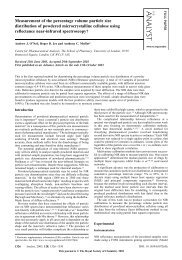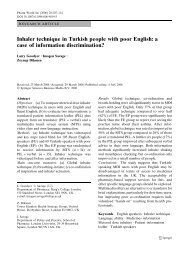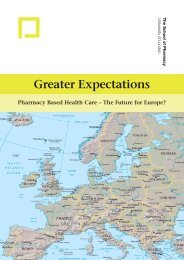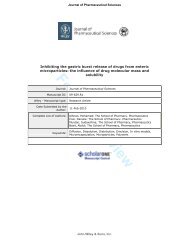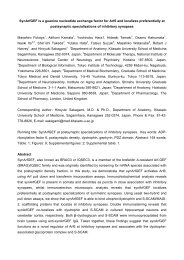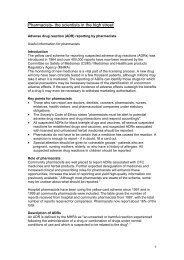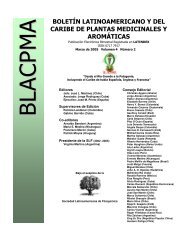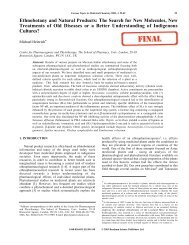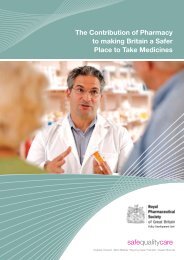A New Route to Spirooxindoles - Pharmacy Eprints
A New Route to Spirooxindoles - Pharmacy Eprints
A New Route to Spirooxindoles - Pharmacy Eprints
Create successful ePaper yourself
Turn your PDF publications into a flip-book with our unique Google optimized e-Paper software.
A <strong>New</strong> <strong>Route</strong> <strong>to</strong> <strong>Spirooxindoles</strong><br />
Stephen T. Hil<strong>to</strong>n, Tim C. T. Ho, Goran Pljevaljcic, and Keith Jones*<br />
School of Chemical and Pharmaceutical Sciences, Kings<strong>to</strong>n UniVersity, Penrhyn Road,<br />
Kings<strong>to</strong>n-upon-Thames, Surrey, KT1 2EE, U.K.<br />
keith.jones@kings<strong>to</strong>n.ac.uk<br />
Received June 6, 2000<br />
ABSTRACT<br />
Reaction of indole amides 5 with tributylstannane gave spiroindolenines 9 which are readily converted in<strong>to</strong> spiropyrrolidinyloxindoles. This<br />
tricyclic system is found in a number of interesting natural products.<br />
A growing number of alkaloids containing the spiropyrrolidinyloxindole<br />
skele<strong>to</strong>n are being discovered. These represent<br />
a wide range of structural complexity, from the simpler<br />
members of the class such as horsfiline 1 1 and elacomine 2 2<br />
<strong>to</strong> the more complex members such as als<strong>to</strong>nisine 3 3 in which<br />
the pyrrolidine portion is part of a bicyclic system (Figure<br />
1). Recently, spirotryprostatin A 4 has been isolated from<br />
Figure 1. Spirooxindole natural products.<br />
the fermentation broth of Aspergillus fumigatus and shown<br />
<strong>to</strong> inhibit the cell cycle and hence have potential as an<br />
(1) Jossang, A.; Jossang, P.; Hadi, H. A.; Sévenet, T.; Bodo, B. J. Org.<br />
Chem. 1991, 56, 6527.<br />
(2) James, M. N. G.; Williams, G. J. B. Can. J. Chem. 1972, 50, 2407.<br />
10.1021/ol0061642 CCC: $19.00 © 2000 American Chemical Society<br />
Published on Web 08/02/2000<br />
ORGANIC<br />
LETTERS<br />
2000<br />
Vol. 2, No. 17<br />
2639-2641<br />
antineoplastic agent. 4 There have been a number of <strong>to</strong>tal<br />
syntheses of horsfiline published 5 as well as a thorough<br />
synthetic study on elacomine and its diastereomer, 6 limited<br />
work on als<strong>to</strong>nisine, 7 and a recent synthesis of spirotryprostatin<br />
A. 8 The elacomine synthesis and the approaches <strong>to</strong><br />
als<strong>to</strong>nisine and spirotryprostatin all proceed through a<br />
tetrahydrocarboline <strong>to</strong> oxindole rearrangement. Some years<br />
ago, we published the first <strong>to</strong>tal synthesis of horsfiline 1 using<br />
an aryl radical cyclization. 5a In trying <strong>to</strong> extend our chemistry<br />
<strong>to</strong> the more complex elacomine 2, we encountered problems<br />
with the regiochemistry of the radical cyclization 9 which led<br />
us <strong>to</strong> completely alter our approach <strong>to</strong> these compounds. It<br />
is this new route that we wish <strong>to</strong> describe in this Letter.<br />
The new route is based on the novel tandem radical<br />
sequence shown in detail in Scheme 1. Reaction of indole<br />
amide 5 with the tributylstannyl radical will produce the aryl<br />
radical 6 by bromine a<strong>to</strong>m abstraction. In the absence of<br />
(3) Elderfield, R. C.; Gilman, R. E. Phy<strong>to</strong>chemistry 1972, 11, 339.<br />
(4) Cui, C.-B.; Kakeya, H.; Okada, G.; Onose, R.; Osada, H. J. Antibiot.<br />
1996, 49, 527.<br />
(5) (a) Jones, K.; Wilkinson, J. J. Chem. Soc., Chem. Commun. 1992,<br />
1767. (b) Bascop, S. I.; Sapi, J.; Laronze, J. Y.; Levy, J. Heterocycles 1994,<br />
38, 725. (c) Pellegrini, C.; Strassler, C.; Weber, M.; Borschberg, H. J.<br />
Tetrahedron: Asymmetry 1994, 5, 1979. (d) Palmisano, G.; Annunziata,<br />
R.; Papeo, G.; Sisti, M. Tetrahedron: Asymmetry 1996, 7, 1. (e) Lakshmaiah,<br />
G.; Kawabata, T.; Shang, M. H.; Fuji, K. J. Org. Chem. 1999, 64,<br />
1699.<br />
(6) Pellegrini, C.; Weber, M.; Borschberg, H. J. HelV. Chim. Acta 1996,<br />
79, 151.<br />
(7) Peterson, A. C.; Cook, J. M. J. Org. Chem. 1995, 60, 120. Yu, P.;<br />
Cook, J. M. Tetrahedron Lett. 1997, 38, 8799.<br />
(8) Edmonson, S.; Danishefsky, S. J.; Sepp-Lorenzino, L.; Rosen, N. J.<br />
Am. Chem. Soc. 1999, 121, 2147.<br />
(9) Ho, T. C. T. Ph.D. Dissertation, University of London, London, U.K.,<br />
1997.
energetically preferred reactions, aryl radicals are well known<br />
<strong>to</strong> undergo [1,5]-hydrogen a<strong>to</strong>m abstraction 10 which in this<br />
case should generate the R-amido radical 7. A report by<br />
Fang 11 has shown that alkyl radicals will add intramolecularly<br />
<strong>to</strong> the 3-position of 2-cyanoindoles which in our case will<br />
generate spiropyrrolidinyl indolenine radical 8. Reduction<br />
of this stabilized radical with tributyltin hydride (TBTH) will<br />
generate cyanoindolenine 9 and more tributylstannyl radical.<br />
Transformation of the cyanoindolenine <strong>to</strong> the oxindole by<br />
oxidative decyanation is well precedented. 12<br />
The synthesis of cyclization precursors 5 commenced with<br />
indole-3-acetic acid 10 (Scheme 2). Formation of the methyl<br />
ester using thionyl chloride in methanol at -78 °C followed<br />
by N-methylation using sodium hydride and methyl iodide<br />
gave the N-methylindole 11 in 91% overall yield. Vilsmeier<br />
formylation of 11 proceeded in some 67% yield on a small<br />
scale, but on a larger scale the yield of 2-formylindole 12<br />
was consistently around 50%. Formation of the oxime 13<br />
using hydroxylamine hydrochloride in ethanol containing<br />
pyridine was uneventful, and elimination in refluxing acetic<br />
anhydride using triethylamine gave the 2-cyanoindole 14 in<br />
69% yield from the aldehyde 12. Hydrolysis of the ester <strong>to</strong><br />
enable elaboration <strong>to</strong> the required amide proved <strong>to</strong> be rather<br />
troublesome. Most of the base-promoted conditions explored<br />
led <strong>to</strong> concomitant hydrolysis of the nitrile <strong>to</strong> the primary<br />
amide possibly via a mechanism involving intramolecular<br />
catalysis by the ester group. However, the very mild<br />
conditions reported by Boger 13 involving lithium hydroxide<br />
in a tert-butyl alcohol/water mixture at room temperature<br />
proved successful and gave the acid 15 in 97% yield.<br />
Coupling of the acid 15 with amines using DCC proved <strong>to</strong><br />
(10) Curran, D. P.; Xu, J. Y. J. Am. Chem. Soc. 1996, 118, 3142.<br />
Beckwith, A. L. J.; S<strong>to</strong>rey, J. M. D. J. Chem. Soc., Chem. Commun. 1995,<br />
977.<br />
(11) Yang, C. C.; Chang, H. T.; Fang, J. J. Org. Chem. 1993, 58, 3100.<br />
(12) Fang, J. M.; Chuang, T. H.; Yang, C. C.; Chang, C. J. Synlett 1990,<br />
733<br />
(13) Boger, D. L.; Borzilleri, R. M.; Nukui, S.; Beresis, R. T. J. Org.<br />
Chem. 1997, 62, 4721.<br />
Scheme 1<br />
be rather low yielding, and so 15 was converted <strong>to</strong> the acid<br />
chloride 16 by careful reaction with oxalyl chloride in THF<br />
at 0 °C. Reaction with 2-bromobenzylamine as its hydrochloride<br />
salt using an excess of diisopropylethylamine in<br />
dichloromethane gave the primary amide 17 in 94% yield.<br />
Unfortunately, it proved impossible <strong>to</strong> alkylate 17 on the<br />
amide nitrogen using base and alkyl halide owing <strong>to</strong> what<br />
appears <strong>to</strong> be a cyclization on<strong>to</strong> the nitrile. Consequently,<br />
acid chloride 16 was reacted with N-methyl-2-bromobenzylamine<br />
and N-ethyl-2-bromobenzylamine 14 <strong>to</strong> give the desired<br />
radical precursors 5a and 5b, respectively, in 84% and 90%<br />
yields.<br />
With these two substrates in hand, we were in a position<br />
<strong>to</strong> study the radical sequence. However, NMR studies of 5a<br />
and 5b clearly demonstrated that two amide rotamers were<br />
present in each case in approximately equal amounts. It is<br />
well established that the lifetime of radicals is generally<br />
insufficient <strong>to</strong> allow amide bond rotation <strong>to</strong> occur. 15 In the<br />
case of 5, one of the two rotamers would be unable <strong>to</strong> cyclize<br />
on<strong>to</strong> the indole-3-position owing <strong>to</strong> its geometry and would<br />
undergo reduction leading <strong>to</strong> a maximum yield for the<br />
sequence of 50%. To aid rotamer interconversion, we carried<br />
out the radical reactions in high-boiling solvents, although<br />
the results indicate this has little beneficial effect. Reaction<br />
of 5a in tert-butylbenzene at 170 °C with TBTH using AIBN<br />
as initia<strong>to</strong>r and syringe pump delivery gave a 30% yield of<br />
the spirocyclic indolenine 9a as a 1:1 mixture of diastereomers.<br />
The pro<strong>to</strong>n NMR of the individual diastereomers of<br />
9a showed three AB quartets for the three methylene groups<br />
and a singlet for the pro<strong>to</strong>n adjacent <strong>to</strong> the nitrile. Along<br />
with the desired product, some 60% of reduced product was<br />
isolated, mainly arising from the “wrong” amide rotamer,<br />
and a small amount of starting material was recovered,<br />
(14) These secondary amines were prepared by the procedure reported<br />
by Fukuyama: Fukuyama, T.; Jow, C.-K.; Cheung, M. Tetrahedron Lett.<br />
1995, 36, 6373. See also: Bowman, W. R.; Coghlan, D. R. Tetrahedron<br />
1997, 53, 15787.<br />
(15) Jones, K.; McCarthy, C. Tetrahedron Lett. 1989, 30, 2657. Musa,<br />
O. M.; Horner, J. H.; <strong>New</strong>comb, M. J. Org. Chem. 1999, 64, 1022.<br />
2640 Org. Lett., Vol. 2, No. 17, 2000
indicating a poor radical chain. The recovered starting<br />
material and the reduced product were both equal mixtures<br />
of amide rotamers, indicating that equilibration occurs under<br />
these conditions but at <strong>to</strong>o slow a rate <strong>to</strong> have an effect on<br />
the radical chemistry. A very similar yield was obtained by<br />
carrying out the reaction in refluxing tert-butyl-m-xylene (206<br />
°C), but no starting material remained. Attempts <strong>to</strong> give the<br />
intermediate radicals a longer lifetime before reduction by<br />
using tristrimethylsilylsilane 16 gave a complex mixture with<br />
evidence of addition <strong>to</strong> the solvent. The success of this<br />
cyclization, in which a primary alkyl radical is generated by<br />
a [1,5]-hydrogen a<strong>to</strong>m abstraction, gave us considerable<br />
cause for optimizm for the reaction of 5b which involves a<br />
secondary alkyl radical. 17 Reaction in tert-butylbenzene under<br />
the same conditions as for 5a gave a 53% yield of 9b as a<br />
(16) Chatgilialoglu, C.; Griller, D.; Lesage, M. J. Org. Chem. 1988, 53,<br />
3641.<br />
(17) Curran, D. P.; Shen, W. J. Am. Chem. Soc. 1993, 115, 6051.<br />
Scheme 2 a<br />
a Reagents and conditions: i, SOCl2, MeOH, -78 <strong>to</strong> 25 °C, 12 h, 99%; ii, NaH, THF, CH3I, 0 °C, 92%; iii, DMF, POCl3, 40°C, 50%;<br />
iv, NH2OH.HCl, EtOH, pyrdine, reflux, 4 h, 95%; v, Ac2O, NEt3, reflux, 4 h, 72%; vi, LiOH‚H2O, t-BuOH:H2O (2:1), 25 °C, 24 h, 97%;<br />
vii, (COCl)2, THF, 0 °C; viii, 2-bromobenzylamine hydrochloride, diisopropylethylamine, CH2Cl2, 0°C, 94% from 15; ix, as viii using<br />
N-methyl-2-bromobenzylamine for 5a, 84% and N-ethyl-2-bromobenzylamine for 5b, 90%; x, KOtBu, O2, THF, 20 °C, 1 h, 41%.<br />
mixture of four diastereomers consisting of two major and<br />
two minor isomers. Again the pro<strong>to</strong>n NMR was distinctive,<br />
showing two AB quartets and a doublet for the methyl group<br />
in each diastereomer. Finally, the mixture of diastereomers<br />
of 9b was converted in moderate yield <strong>to</strong> oxindole 18 (as a<br />
1:1.3 ratio of two diastereomers) on treatment with potassium<br />
tert-bu<strong>to</strong>xide and oxygen in THF. 12<br />
In summary, we have developed a novel route <strong>to</strong> spiropyrrolidinyloxindoles<br />
which utilizes a tandem radical sequence<br />
involving a [1,5]-hydrogen a<strong>to</strong>m abstraction/cyclization.<br />
The synthesis is highly convergent and flexible. We<br />
are now investigating the application of this chemistry <strong>to</strong><br />
the preparation of natural products and their analogues.<br />
Acknowledgment. We thank Kings<strong>to</strong>n University and<br />
EU for funding this research. We are also grateful <strong>to</strong> Dr. J.<br />
M. D. S<strong>to</strong>rey for helpful discussions.<br />
OL0061642<br />
Org. Lett., Vol. 2, No. 17, 2000 2641



